 |
| Stonehenge in the
United Kingdom (Late Neolithic from 3000 to 2000
BC). |
History
The history of Europe covers the peoples inhabiting
Europe from prehistory to the present.
The period known as classical antiquity began with the
emergence of the city-states of ancient Greece. Later,
the Roman Empire came to dominate the entire
Mediterranean basin. The fall of the Roman Empire in AD
476 traditionally marks the start of the Middle Ages.
Beginning in the 14th century a Renaissance of knowledge
challenged traditional doctrines in science and
theology. Simultaneously, the Protestant Reformation set
up Protestant churches primarily in Germany, Scandinavia
and England.
After 1800, the Industrial Revolution brought prosperity
to Britain and Western Europe.
The main powers set up colonies in most of the Americas
and Africa, and parts of Asia.
In the 20th century, World War I, and World War II
resulted in massive numbers of deaths.
The Cold War dominated European geo-politics from 1947
to 1989.
Unification into a European Union moved forward after
1950, with some setbacks.
Today, most countries west of Russia belong to the NATO
military alliance, along with the United States and
Canada. |
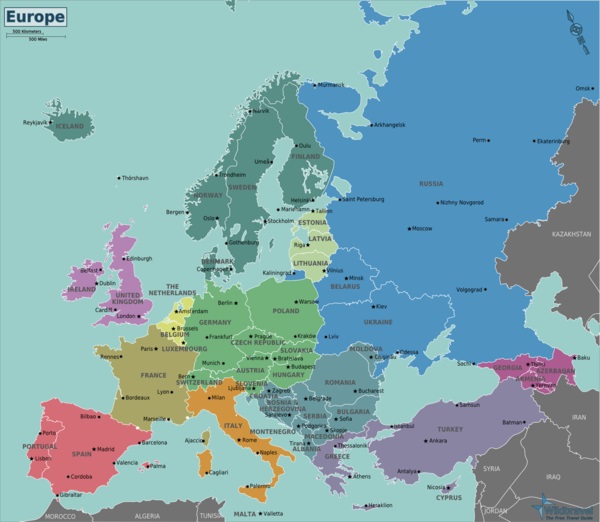 |
| A map showing the
countries of Europe. |
Geography
Europe makes up the western fifth of the Eurasian
landmass. It has a higher ratio of coast to landmass
than any other continent or subcontinent. Its maritime
borders consist of the Arctic Ocean to the north, the
Atlantic Ocean to the west, and the Mediterranean,
Black, and Caspian Seas to the south.
Land relief in Europe shows great variation within
relatively small areas. The southern regions are more
mountainous, while moving north the terrain descends
from the high Alps, Pyrenees, and Carpathians, through
hilly uplands, into broad, low northern plains, which
are vast in the east. This extended lowland is known as
the Great European Plain, and at its heart lies the
North German Plain. An arc of uplands also exists along
the north-western seaboard, which begins in the western
parts of the islands of Britain and Ireland, and then
continues along the mountainous, fjord-cut spine of
Norway. |
Climate
Europe lies mainly in the temperate climate zones, being
subjected to prevailing westerlies. The climate is
milder in comparison to other areas of the same latitude
around the globe due to the influence of the Gulf
Stream. The Gulf Stream is nicknamed "Europe's central
heating", because it makes Europe's climate warmer and
wetter than it would otherwise be. The Gulf Stream not
only carries warm water to Europe's coast but also warms
up the prevailing westerly winds that blow across the
continent from the Atlantic Ocean.
Therefore, the average temperature throughout the year
of Naples is 16 °C (61 °F), while it is only 12 °C (54
°F) in New York City which is almost on the same
latitude. Berlin, Germany; Calgary, Canada; and Irkutsk,
in the Asian part of Russia, lie on around the same
latitude; January temperatures in Berlin average around
8 °C (14 °F) higher than those in Calgary, and they are
almost 22 °C (40 °F) higher than average temperatures in
Irkutsk. Similarly, northern parts of Scotland have a
tempertate marine climate. The yearly average
temperature in city of Inverness is 9.05 °C (48.29 °F).
However, Churchill, Manitoba, Canada, is on roughly the
same latitude and has an average temperature of −6.5 °C
(20.3 °F), giving it a nearly subarctic climate. |
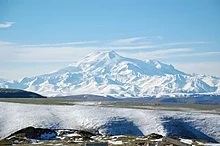 |
| Mount Elbrus in
Southern Russia, is the highest mountain in
Europe. |
Geology
The geology of Europe is hugely varied and complex, and
gives rise to the wide variety of landscapes found
across the continent, from the Scottish Highlands to the
rolling plains of Hungary.
Europe's most significant feature is the difference
between highland and mountainous Southern Europe and a
vast, partially underwater, northern plain ranging from
Ireland in the west to the Ural Mountains in the east.
These two halves are separated by the mountain chains of
the Pyrenees and Alps/Carpathians.
The northern plains are delimited in the west by the
Scandinavian Mountains and the mountainous parts of the
British Isles. Major shallow water bodies submerging
parts of the northern plains are the Celtic Sea, the
North Sea, the Baltic Sea complex and Barents Sea.
The northern plain contains the old geological continent
of Baltica, and so may be regarded geologically as the
"main continent". Most of the older geology of western
Europe existed as part of the ancient microcontinent
Avalonia. |
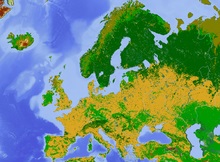 |
| Land use map of
Europe with arable farmland (yellow), forest
(dark green), pasture (light green), and tundra
or bogs in the north (dark yellow). |
Flora
Having lived side-by-side with agricultural peoples for
millennia, Europe's animals and plants have been
profoundly affected by the presence and activities of
man. With the exception of Fennoscandia and northern
Russia, few areas of untouched wilderness are currently
found in Europe, except for various national parks.
The main natural vegetation cover in Europe is mixed
forest. Few corners of mainland Europe have not been
grazed by livestock at some point in time, and the
cutting down of the pre-agricultural forest habitat
caused disruption to the original plant and animal
ecosystems.
Probably 80 to 90 percent of Europe was once covered by
forest. It stretched from the Mediterranean Sea to the
Arctic Ocean. Though over half of Europe's original
forests disappeared through the centuries of
deforestation, Europe still has over one quarter of its
land area as forest, such as the broadleaf and mixed
forests, taiga of Scandinavia and Russia, mixed
rainforests of the Caucasus and the Cork oak forests in
the western Mediterranean. During recent times,
deforestation has been slowed and many trees have been
planted.
In temperate Europe, mixed forest with both broadleaf
and coniferous trees dominate. The most important
species in central and western Europe are beech and oak.
In the north, the taiga is a mixed spruce–pine–birch
forest; further north within Russia and extreme northern
Scandinavia, the taiga gives way to tundra as the Arctic
is approached. In the Mediterranean, many olive trees
have been planted, which are very well adapted to its
arid climate; Mediterranean Cypress is also widely
planted in southern Europe. The semi-arid Mediterranean
region hosts much scrub forest. A narrow east-west
tongue of Eurasian grassland (the steppe) extends
eastwards from Ukraine and southern Russia and ends in
Hungary and traverses into taiga to the north. |
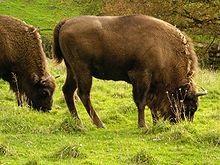 |
| Once roaming the
great temperate forests of Eurasia, European
bison now live in nature preserves in Białowieża
Forest, on the border between Poland and
Belarus. |
Fauna
Glaciation during the most recent ice age and the
presence of man affected the distribution of European
fauna. As for the animals, in many parts of Europe most
large animals and top predator species have been hunted
to extinction.
The woolly mammoth was extinct before the end of the
Neolithic period. Today wolves (carnivores) and bears
(omnivores) are endangered. Once they were found in most
parts of Europe. However, deforestation and hunting
caused these animals to withdraw further and further. By
the Middle Ages the bears' habitats were limited to more
or less inaccessible mountains with sufficient forest
cover.
Today, the brown bear lives primarily in the Balkan
peninsula, Scandinavia, and Russia; a small number also
persist in other countries across Europe (Austria,
Pyrenees etc.), but in these areas brown bear
populations are fragmented and marginalised because of
the destruction of their habitat. In addition, polar
bears may be found on Svalbard, a Norwegian archipelago
far north of Scandinavia. The wolf, the second largest
predator in Europe after the brown bear, can be found
primarily in Central and Eastern Europe and in the
Balkans, with a handful of packs in pockets of Western
Europe (Scandinavia, Spain, etc.).
European wild cat, foxes (especially the red fox),
jackal and different species of martens, hedgehogs,
different species of reptiles (like snakes such as
vipers and grass snakes) and amphibians, different birds
(owls, hawks and other birds of prey).
Important European herbivores are snails, larvae, fish,
different birds, and mammals, like rodents, deer and roe
deer, boars, and living in the mountains, marmots,
steinbocks, chamois among others. A number of insects,
such as the small tortoiseshell butterfly, add to the
biodiversity.
The extinction of the dwarf hippos and dwarf elephants
has been linked to the earliest arrival of humans on the
islands of the Mediterranean.
Sea creatures are also an important part of European
flora and fauna. The sea flora is mainly phytoplankton.
Important animals that live in European seas are
zooplankton, molluscs, echinoderms, different
crustaceans, squids and octopuses, fish, dolphins, and
whales.
Biodiversity is protected in Europe through the Council
of Europe's Bern Convention, which has also been signed
by the European Community as well as non-European
states. |
|
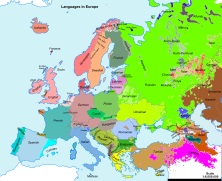 |
| Distribution of
major languages of Europe. |
Demographics
In 2017, the population of Europe was estimated to be
742 million according to the 2019 revision of the World
Population Prospects , which is slightly more than
one-ninth of the world's population. This number
includes Siberia, (about 38 million people) but excludes
European Turkey (about 12 million).
A century ago, Europe had nearly a quarter of the
world's population. The population of Europe has grown
in the past century, but in other areas of the world (in
particular Africa and Asia) the population has grown far
more quickly. Among the continents, Europe has a
relatively high population density, second only to Asia.
Most of Europe is in a mode of Sub-replacement
fertility, which means that each new(-born) generation
is being less populous than the older.
The most densely populated country in Europe (and in the
world) is the microstate of Monaco.
Languages
European languages mostly fall within three
Indo-European language groups: the Romance languages,
derived from the Latin of the Roman Empire; the Germanic
languages, whose ancestor language came from southern
Scandinavia; and the Slavic languages.
Slavic languages are most spoken by the number of native
speakers in Europe, they are spoken in Central, Eastern,
and Southeastern Europe. Romance languages are spoken
primarily in south-western Europe as well as in Romania
and Moldova, in Eastern Europe. Germanic languages are
spoken in Northern Europe, the British Isles and some
parts of Central Europe.
Many other languages outside the three main groups exist
in Europe. Other Indo-European languages include the
Baltic group (that is, Latvian and Lithuanian), the
Celtic group (that is, Irish, Scottish Gaelic, Manx,
Welsh, Cornish, and Breton), Greek, Armenian, and
Albanian. In addition, a distinct non-Indo-European
family of Uralic languages (Estonian, Finnish, and
Hungarian) is spoken mainly in Estonia, Finland, and
Hungary, while Kartvelian languages (Georgian,
Mingrelian, and Svan), are spoken primarily in Georgia,
and two other language families reside in the North
Caucasus (termed Northeast Caucasian, most notably
including Chechen, Avar and Lezgin and Northwest
Caucasian, notably including Adyghe). Maltese is the
only Semitic language that is official within the EU,
while Basque is the only European language isolate.
Turkic languages include Azerbaijani and Turkish, in
addition to the languages of minority nations in Russia.
Multilingualism and the protection of regional and
minority languages are recognised political goals in
Europe today. The Council of Europe Framework Convention
for the Protection of National Minorities and the
Council of Europe's European Charter for Regional or
Minority Languages set up a legal framework for language
rights in Europe. |
|